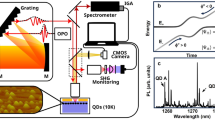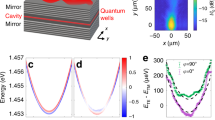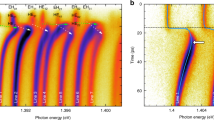Abstract
Semiconductor light emission can be changed considerably in an optical resonator1. Prerequisite is that the electronic transitions involved in light generation are in resonance with a cavity mode. Although resonance can be arranged through dedicated fabrication, there are cases where this is virtually impossible. As an example, we study a planar microcavity containing an inhomogeneous quantum dot ensemble with a spectral broadening much larger than the optical mode width, so that resonance is achieved for a tiny dot fraction only. Still, the laser threshold can be crossed at moderate optical pumping. We demonstrate that strain pulses generated by ultrafast acoustics techniques can be used to modulate the transition energies so that resonance with the optical mode is dynamically induced for a much larger dot fraction. As a result, the emission output can be enhanced by more than two orders of magnitude, which is potentially useful for modulating light sources.
This is a preview of subscription content, access via your institution
Access options
Subscribe to this journal
Receive 12 print issues and online access
$209.00 per year
only $17.42 per issue
Buy this article
- Purchase on Springer Link
- Instant access to full article PDF
Prices may be subject to local taxes which are calculated during checkout




Similar content being viewed by others
References
Vahala, K. J. Optical microcavities. Nature 424, 839–846 (2003).
Gerard, J. M. et al. Enhanced spontaneous emission by quantum boxes in a monolithic optical microcavity. Phys. Rev. Lett. 81, 1110–1113 (1998).
Weisbuch, C., Nishioka, M., Ishikawa, A. & Arakawa, Y. Observation of the coupled exciton–photon mode splitting in a semiconductor quantum microcavity. Phys. Rev. Lett. 69, 3314–3317 (1992).
Reithmaier, J. P. et al. Strong coupling in a single quantum dot–semiconductor microcavity system. Nature 432, 197–200 (2004).
Yoshie, T. et al. Vacuum Rabi splitting with a single quantum dot in a photonic crystal nanocavity. Nature 432, 200–203 (2004).
Michler, P. et al. A quantum dot single-photon turnstile device. Science 290, 2282–2285 (2000).
Young, R. J. et al. Improved fidelity of triggered entangled photons from single quantum dots. New J. Phys. 8, 29 (2006).
Akopian, N. et al. Entangled photon pairs from semiconductor quantum dots. Phys. Rev. Lett. 96, 130501 (2006).
Dousse, A. et al. Ultrabright source of entangled photon pairs. Nature 466, 217–220 (2010).
Kasprzak, J. et al. Bose–Einstein condensation of exciton polaritons. Nature 443, 409–414 (2006).
Deng, H., Weihs, G., Santori, C., Bloch, J. & Yamamoto, Y. Condensation of semiconductor microcavity exciton polaritons. Science 298, 199–202 (2002).
Balili, R., Hartwell, V., Snoke, D., Pfeiffer, L. & West, K. Bose–Einstein condensation of microcavity polaritons in a trap. Science 316, 1007–1010 (2007).
Amo, A. et al. Collective fluid dynamics of a polariton condensate in a semiconductor microcavity. Nature 457, 291–295 (2009).
Kistner, C. et al. Demonstration of strong coupling via electro-optical tuning in high-quality QD–micropillar systems. Opt. Express 16, 15006–15012 (2008).
Reitzenstein, S. et al. Control of the strong light–matter interaction between an elongated In0.3Ga0.7As quantum dot and a micropillar cavity using external magnetic fields. Phys. Rev. Lett. 103, 127401 (2009).
Scherbakov, A. V. et al. Chirping of an optical transition by an ultrafast acoustic soliton train in a semiconductor quantum well. Phys. Rev. Lett. 99, 057402 (2007).
Berstermann, T. et al. Terahertz polariton sidebands generated by ultrafast strain pulses in an optical semiconductor microcavity. Phys. Rev. B 80, 075301 (2009).
Kaniber, M. et al. Investigation of the nonresonant dot–cavity coupling in two-dimensional photonic crystal nanocavities. Phys. Rev. B 77, 161303(R) (2008).
Ates, S. et al. Non-resonant dot–cavity coupling and its potential for resonant single-quantum-dot spectroscopy. Nature Photon. 3, 724–728 (2009).
Press, D. et al. Photon antibunching from a single quantum-dot–microcavity system in the strong coupling regime. Phys. Rev. Lett. 98, 117402 (2007).
Hennessy, K. et al. Quantum nature of strongly coupled single quantum dot–cavity system. Nature 445, 896–899 (2007).
Winger, M. et al. Explanation of photon correlation in the far-off-resonance optical emission from a quantum-dot–cavity system. Phys. Rev. Lett. 103, 207403 (2009).
Thomsen, C., Grahn, H. T., Maris, H. J. & Tauc, J. Surface generation and detection of phonons by picosecond light pulses. Phys. Rev. B 34, 4129–4138 (1986).
Karpman, V. I. Non-Linear Waves in Dispersive Media (Pergamon Press, 1975).
Lanzillotti-Kimura, N. D., Fainstain, A., Balseiro, C. A. & Jusserand, B. Phonon engineering with acoustic nanocavities: theoretical considerations on phonon molecules, band structures, and acoustic Bloch oscillations. Phys. Rev. B 75, 024301 (2007).
Berstermann, T. et al. Optical bandpass switching by modulating a microcavity using ultrafast acoustics. Phys. Rev. B 81, 085316 (2010).
Tanebe, T., Kuramochi, E., Taniyama, H. & Notomi, M. Electro-optic adiabatic wavelength shifting and Q switching demonstrated using a p–i–n integrated photonic crystal nanocavity. Opt. Lett. 35, 3895–3897 (2010).
Maune, B. et al. Optically triggered Q-switched photonic crystal laser. Opt. Express 13, 4699–4707 (2005).
Beardsley, R. P., Akimov, A. V., Henini, M. & Kent, A. J. Coherent terahertz sound amplification and spectral line narrowing in a Stark ladder superlattice. Phys. Rev. Lett. 104, 085501 (2010).
Acknowledgements
The authors acknowledge financial support by the Deutsche Forschungsgemeinschaft (project BA 1549/14-1), the Russian Academy of Sciences and the State of Bavaria.
Author information
Authors and Affiliations
Contributions
A.V.A., M.Ba. and D.R.Y. developed the idea for the experiment. C.B., M.Bo. and A.V.S. performed the experiment. C.B. processed the data. C.B., A.V.A. and M.Ba. analysed and interpreted the results and wrote the manuscript. C.S., S.H. and A.F. fabricated the microcavity sample. All authors discussed the results and the manuscript.
Corresponding author
Ethics declarations
Competing interests
The authors declare no competing financial interests.
Supplementary information
Supplementary information
Supplementary information (PDF 302 kb)
Rights and permissions
About this article
Cite this article
Brüggemann, C., Akimov, A., Scherbakov, A. et al. Laser mode feeding by shaking quantum dots in a planar microcavity. Nature Photon 6, 30–34 (2012). https://doi.org/10.1038/nphoton.2011.269
Received:
Accepted:
Published:
Issue Date:
DOI: https://doi.org/10.1038/nphoton.2011.269
This article is cited by
-
Large non-thermal contribution to picosecond strain pulse generation using the photo-induced phase transition in VO2
Nature Communications (2020)
-
High-speed modulation of a terahertz quantum cascade laser by coherent acoustic phonon pulses
Nature Communications (2020)
-
Coupling the normal incident light into waveguide modes of DBR mirrors via a diffraction grating
Scientific Reports (2016)
-
Heterodyne mixing of millimetre electromagnetic waves and sub-THz sound in a semiconductor device
Scientific Reports (2016)
-
Quantum dynamics of optical phonons generated by optical excitation of a quantum dot
Journal of Computational Electronics (2016)



